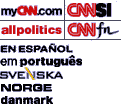| CNN WEB SITES: |

|
| TIME INC. SITES: |
| MORE SERVICES: |
| video on demand |
| video archive |
| audio on demand |
| news email services |
| free email accounts |
| desktop headlines |
| pointcast |
| pagenet |
| DISCUSSION: |
| message boards |
| chat |
| feedback |
| SITE GUIDES: |
| help |
| contents |
| search |
| FASTER ACCESS: |
| europe |
| japan |
| WEB SERVICES: |
Marlboro Man hangs up billboard hat

| ||||||||||||
Dismantling the Marlboro Man -- hat first
|
||||||||||||
Outdoor tobacco ads being replaced
April 23, 1999
Web posted at: 9:58 a.m. EDT (1358 GMT)
In this story: What is banned, what isn't 'I miss my lung, Bob' Tobacco industry shifts marketing strategy RELATED STORIES, SITES |
Even so, cigarette makers are far from being snuffed out.
Under a $206 billion settlement reached in November with 46 states, the major tobacco companies agreed to remove thousands of billboard ads, but keep paying for the space until their leases expire so that anti-smoking groups can use them. Midnight Thursday was the deadline.
The deal includes cigarette makers Philip Morris, RJR Nabisco, Brown and Williamson and Lorillard, as well as smokeless tobacco maker UST Corp.
The settlement bans:
- All outdoor advertising of tobacco products, such as billboards at stadiums, as well as similar advertising at such places as arenas and shopping malls.
- Distribution and sale of clothing and merchandise such as caps, T-shirts and backpacks with brand name logos.
- The use of cartoons in the advertising and packaging of tobacco products.
Ads up to 14 square feet still are permitted at stores that sell tobacco products.
While some states have designed their own replacement billboards -- paid for by the tobacco companies -- the U.S. Centers for Disease Control and Prevention, the Food and Drug Administration and the National Cancer Institute designed several of their own, many based on designs created by the states of Massachusetts and California.
Some are takeoffs on the familiar ads, showing cowboys chatting. But instead of lighting up, one of the faux Marlboro men laments about his poor health, telling his buddy: "I miss my lung, Bob."
Others carry blunt warnings such as, "Warning: When used as directed cigarettes kill".

| |
| Tobacco advertisements painted on the sides of barns are not part of the settlement and will remain part of the landscape | |
Anti-smoking activists, while heartened by the billboard ban, see one battle won, but the war still on.
"We must not lose sight of the fact that it will take further action by public health officials and local communities to reduce the health effects attributed to tobacco use," said Health and Human Services Secretary Donna Shalala.
Tobacco industry shifts marketing strategy
The tobacco industry embraced outdoor advertising after cigarette ads were banned from television in 1971.
But since the late 1980s -- long before the billboard ban settlement -- the industry has been shifting its resources away from billboards.
While overall magazine ad spending rose 7.8 percent last year, tobacco ads grew by three times that amount -- almost 25 percent -- to $375 million.
The industry also is using more retail store displays, direct mail and hosting events in what it calls "adult restricted environments," also known as bars.
"We actually work with bars to offer them what we would call added value for their consumers by hosting evenings where there are promotions and activities for their patrons," says Philip Morris Senior Vice President Ellen Merlo

| |
| After being banned from television advertising in the 1970s, the tobacco industry turned to outdoor advertising | |
"We will be able to market our products to adults who choose to smoke in a very effective responsible way," she told CNN.
The Health and Human Services department said tobacco companies spent $300 million on billboards in 1996.
While outdoor advertising is no longer a big budget item, anti-tobacco forces say the industry won't have a hard time getting its message through.
"Today, they spend far more money plastering convenience stores with their imagery, paying convenience store owners to put cigarettes near where kids will see them," said Matt Myers of Smoke-Free Kids.
With tobacco billboards gone, the change in the landscape of tobacco advertising will be obvious. The long-term effect may not be.
Correspondents Aram Roston, Peter Viles and Reuters contributed to this report.
RELATED STORIES:
Philip Morris hit with record tobacco liability verdict
March 30, 1999
Study takes aim at smoking and drinking in animated films
March 18, 1999
Justice Department wants $20 million to sue tobacco industry
February 1, 1999
States vow to deny Clinton administration a share in tobacco settlements
January 21, 1999
RELATED SITES:
Tobacco Industry, Table of Cases
The National Smoker's Alliance
Tobacco Information and Prevention Sourcepage
Foundation for a Smoke-Free America
Smokers Home Page
Note: Pages will open in a new browser windowExternal sites are not endorsed by CNN Interactive.
| LATEST HEADLINES: |